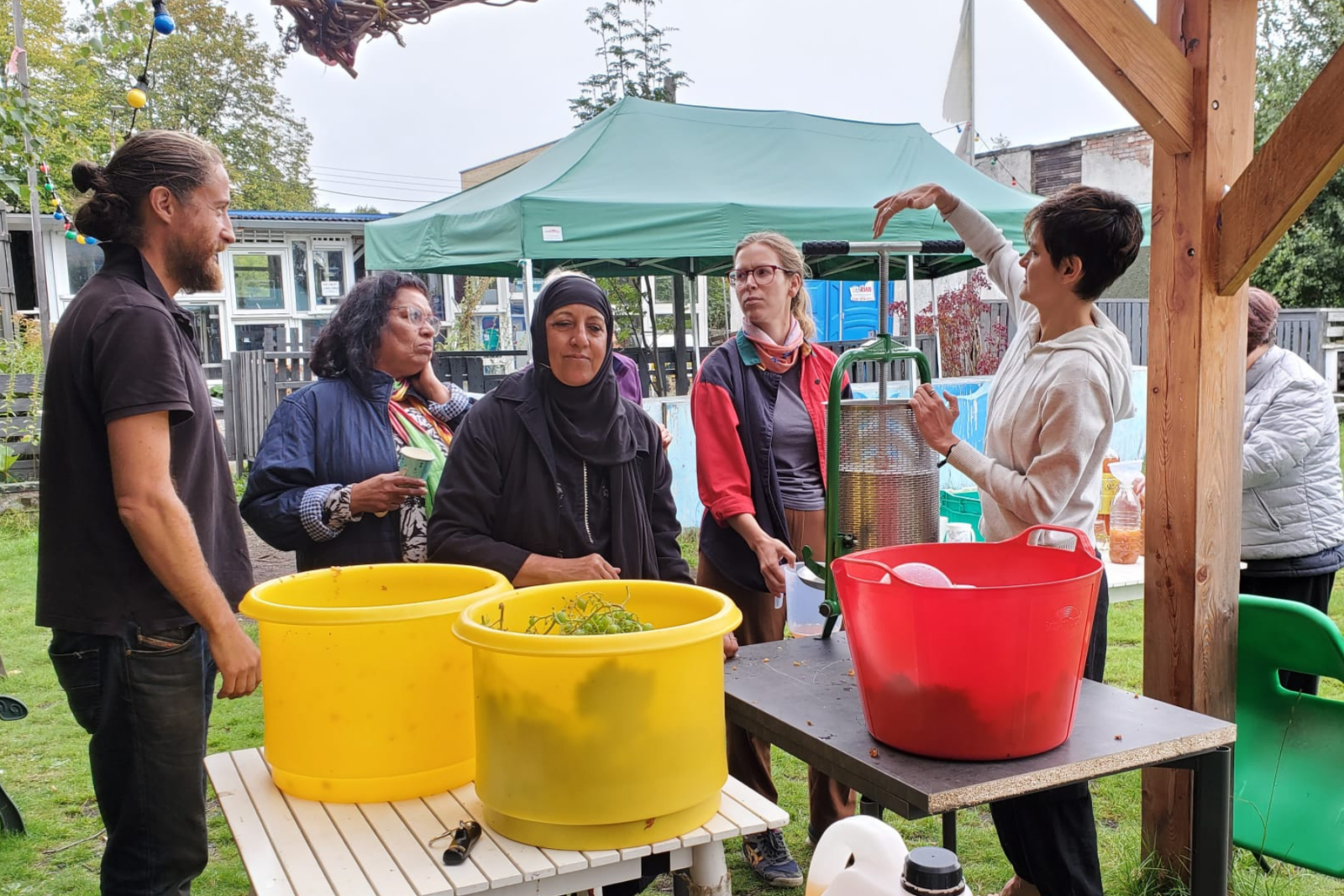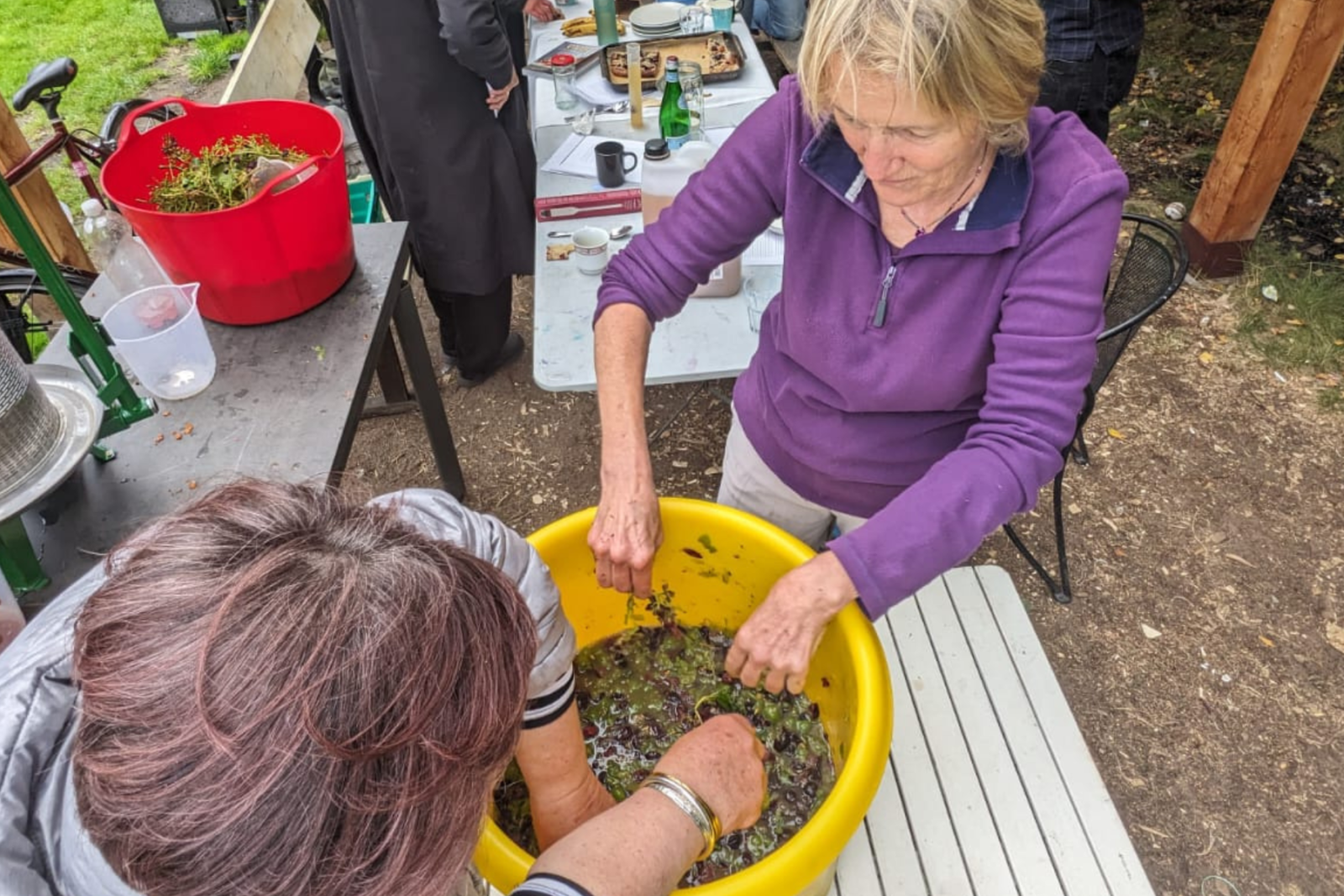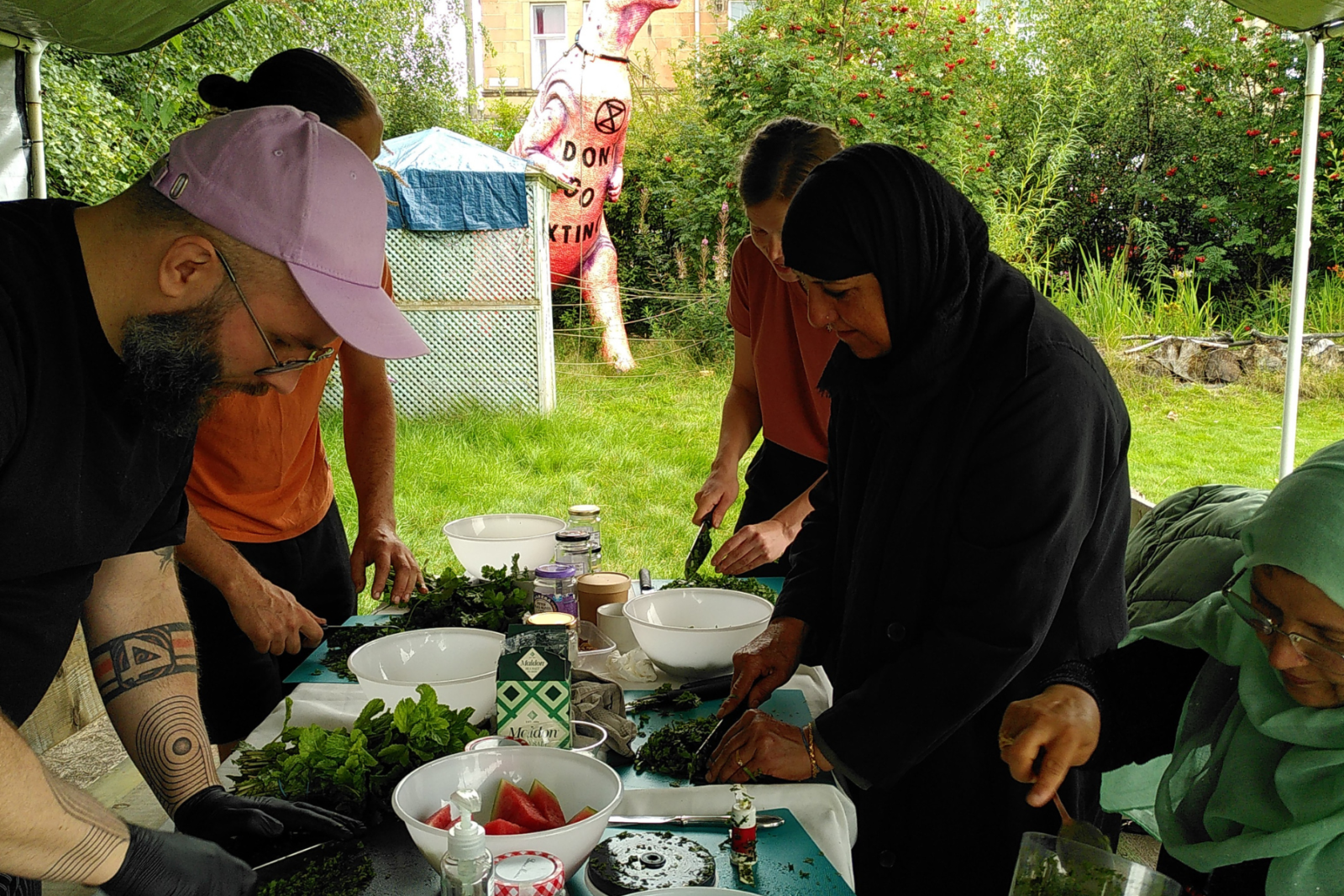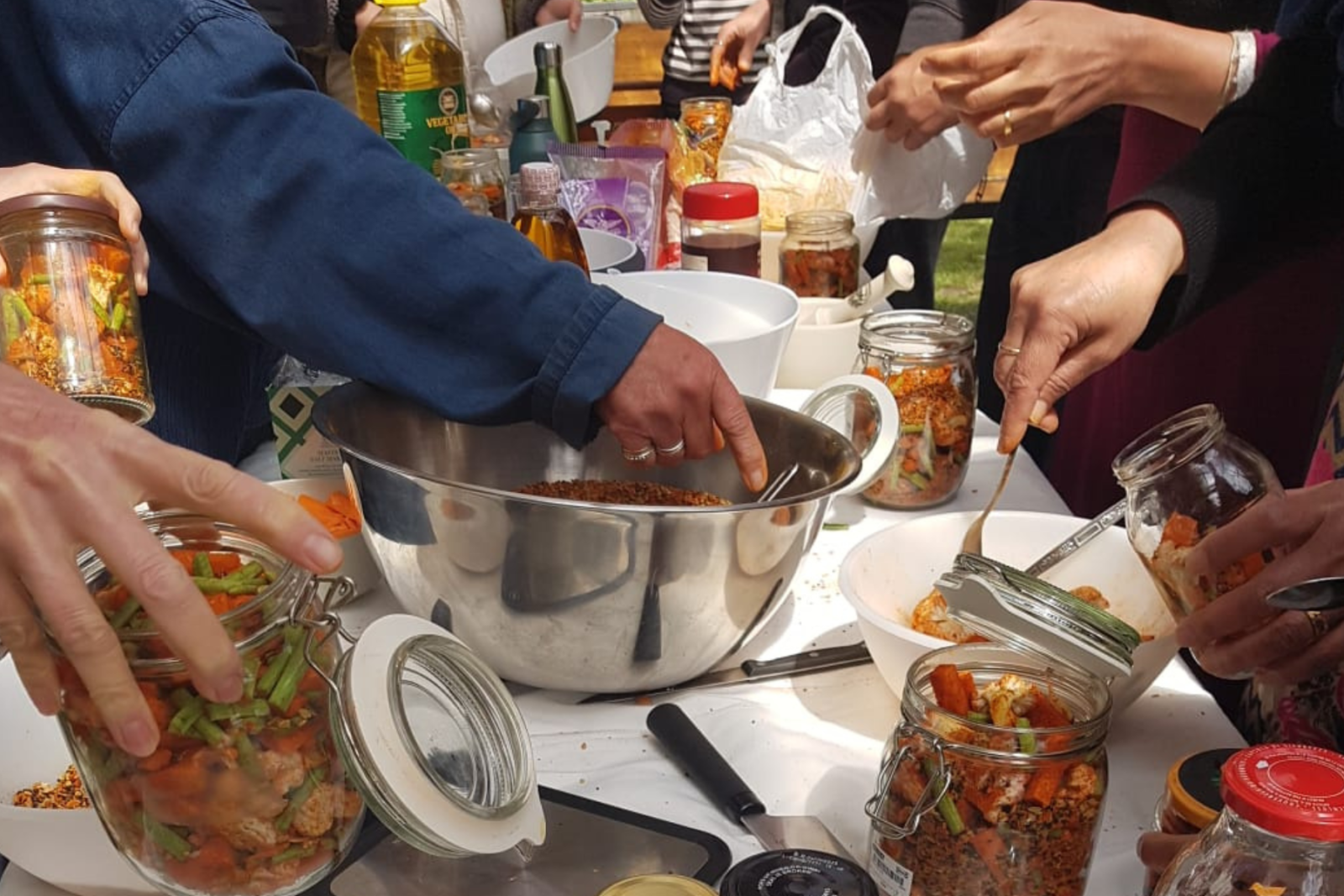- News
Fermentation, Climate, and Community

It’s a bright Thursday morning in Pollokshields, and the small community garden is alive with colour and chatter. At one table, jars glint in the sunlight, waiting to be filled. Around them, a group of people slice carrots, radishes and green chillies, mixing them with mustard seeds, turmeric, oil and a generous scattering of salt. The warm scent of spices drifts through the air, mingling with the fresh, earthy smell of the garden.
Laughter ripples through the group as someone recalls last month’s tempeh-making session — the careful wrapping, the slow transformation, our nerves about using fungi — while another offers tips on just how much chilli heat achar can take.
This isn’t just a cooking session — it’s the monthly meeting of the Community Fermentation Club. Today, we’re making a South Asian-style fermented pickle together, surrounded by the buzzing of bees, the warmth of the sun, and the quiet work of the microbes that will soon turn these vegetables into something tangy, complex and delicious.

Fermentation as a Future-Facing Practice
Fermentation has been around for thousands of years, yet it feels more relevant than ever. It’s a way to preserve food, yes — but also to enhance it, transform it, and create something entirely new. Fermentation is often thought of as a preservation method — a way to stop food from going off. But it’s more than that. It’s a form of culinary time travel. It stretches the life of ingredients, transforms their flavours, and opens the door to entirely new creations. Every jar of sauerkraut or crock of kimchi is alive with possibilities. In a time of climate uncertainty and resource scarcity, fermentation offers a model of resilience: waste less, store more, diversify flavours, and stay connected to seasonal and local abundance. It is also a link to the past, directly connecting us to our ancestors who relied upon it for preservation and nutrition.1
Nevertheless, a tension exists between fermentation as accessible practice, fermented foods as artisanal brands, and precision fermentation. The modern wave of fermentation businesses often stands in stark contrast to fermentation’s deep, communal roots. Historically, fermentation was a humble, ingenious method of preserving abundant, seasonal produce and making it safe, nutritious, and accessible for everyone. Sauerkraut, miso, sourdough, and countless other fermented foods emerged from necessity, resourcefulness, and shared knowledge, sustaining communities through scarcity. Yet in today’s gentrified food economy, these same traditions are frequently repackaged as exclusive lifestyle products, priced far beyond the reach of the very communities that birthed them. This tension reveals how a practice once defined by collective benefit and affordability can be transformed into a symbol of status—stripping away its accessibility while capitalizing on its cultural capital.
Food futurism often casts fermentation as a cutting-edge frontier, harnessing scientific precision to create novel flavours, textures, and nutritional profiles far beyond traditional pickles or sourdough. Advances in microbiology and bioprocess engineering now enable the cultivation of designer microbes, precision-brewing of proteins, and fermentation-based production of everything from dairy-free cheese to lab-grown palm oil—promising solutions to environmental crises and the ethical pitfalls of industrial agriculture. These innovations, showcased in sleek R&D kitchens and speculative menus, carry the allure of progress, yet also raise questions about accessibility, ownership, and cultural continuity. While scientific fermentation offers the potential to reduce waste, lower carbon footprints, and feed growing populations, it risks reproducing the exclusivity and detachment of other high-tech food trends.
As geographer Jamie Lorimer notes, fermentation represents a shift away from the modernist mindset of strict control towards a more open, collaborative engagement with living systems2. In our club, we embrace that shift — and the messiness that comes with it.

Building Community — Human and Microbial
One of the club’s guiding principles is to focus not just on individual health but on community-level wellbeing. “Individualised health solutions, individualise our food problems”3 — and food problems are systemic, tied to supply chains, climate change, and cultural disconnection.
In our monthly gatherings, we build relationships on two levels: with each other and with the microbial worlds in our jars. Human and microbes have co-evolved, each community dependent on the other. People and microbes cannot live in isolation, each depend on community with themselves and with each other.4
In our group we attempt to actively build community with microbes and one another.
A member described it perfectly:
“Holistically and spiritually speaking, I think fermentation is an anti-binary practice. It centres slowness, acknowledges failures as part of learning, is community-oriented and leads to discussion. It’s mind-broadening in the possibilities and in the option to customise what we eat. It also contributes to respect for produce and making processes.”
Another shared:
“The geekiness and genuine curiosity about trying new things — that’s something I value and don’t take for granted. Same with cross-cultural curiosity.”
And one more:
“I feel the group validates some traits that I value — like weirdness, hyperfocus, playfulness and collective learning — so I feel validated in those traits when I engage with the group.”
These are not side benefits; they’re part of the reason fermentation matters. It’s a social glue as much as it is a preservation method.

Learning by Doing (and Sometimes Failing)
Since our first meeting in August 2022, we’ve made sauerkraut, kimchi, kombucha, yoghurt, miso, shio koji, vinegar, and more. The approach is DIY and playful. We favour experimentation over expertise and see “failures” as opportunities to learn.
One member reflected on the chat group that runs alongside our in-person sessions:
“I like to check in with the enthusiasm and warm support that exists in the chat; when people share disasters or successes and are met with kind responses, when we exchange herbs or ask if someone has a jar or tips on where to find an ingredient. It’s always a warm and welcoming space and encourages learning that I appreciate a lot.”
This peer-to-peer knowledge sharing echoes traditional fermentation cultures worldwide, where recipes and skills are passed through conversation, demonstration, and shared meals.
Fermentation as Climate Action
Fermentation is more than a kitchen craft; it’s a way to engage critically with the food system. Using locally grown or foraged produce links us to our local ecosystems — their seasons, soils, and microbial diversity.
The monthly meet ups serve as a jumping off point to explore the complexities of the food system, and its relationship with climate change. Actively engaging people with their own food worlds5 is an opportunity to support people’s learning about the complexities of the food system and highlight opportunities for action.
As Sandor Katz6 points out in The Art of Fermentation, every fruit and vegetable is covered with wild lactic acid bacteria, ready to turn sugars into acids and preserve the harvest. Working with these local microbes is a way of rooting ourselves in place. Yet, in the spirit of diversity, we also welcome microbes from other cultures: Bulgarian yoghurt starters (Lactobacillus delbrueckii subsp. bulgaricus), Greek Streptococcus thermophilus, Japanese Aspergillus oryzae for miso and koji. Each carries flavour, texture, and cultural history.
In this way, fermentation allows us to talk about — and taste — global interconnection, not just as a supply chain problem but as a network of microbial and human relationships.

An Act of Care
Fermentation is an act of care: for ourselves, for others, and for the more-than-human worlds we live in. Caring for microbes — feeding them, keeping them warm or cool, giving them time — teaches patience. Sharing the results is a way of nourishing relationships.
The anthropologist Heather Paxson describes fermentation as a “co-production” between humans and microbes7. This co-production can resist purely extractive, market-driven ways of thinking about nature, offering instead a slower, reciprocal model.
Whether in a community garden in Pollokshields or a kitchen table in someone’s flat, fermentation gives us a tangible, delicious way to think about climate, culture, and cooperation — and to taste the future we want to build.
Footnotes
- Skinner, Julia (2022). Our Fermented Lives: A History of How Fermented Foods Have Shaped Cultures & Communities London: Storey
- Lorimer, J. (2020). Probiotics Ecologies: Nature, Space and Politics in the Microbiome. Geography Compass, 12(2). Open access
- Lang, T. (2020) Feeding Britains: Our food problems and how to fix them. London: Penguin
- Hendy, Jessica, Matthäus Rest, Mark Aldenderfer and Christina Warinner. 2023. "Cultures of Fermentation: Living with Microbes: An Introduction to Supplement 24." Current Anthropology 62 (Supplement 24): S1-S15.
- Baggini, J (2024) How the World Eats: A Global Food Philosophy London: Granta
- Katz, S (2012). The Art of Fermentation. Chelsea Green
- Paxson, H. (2008). Post-Pasteurian Cultures: The Microbiopolitics of Raw-Milk Cheese in the United States. Cultural Anthropology, 23(1), 15-47. Open access
